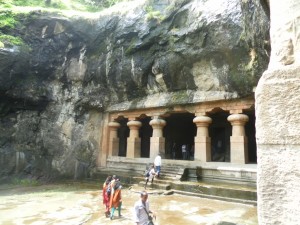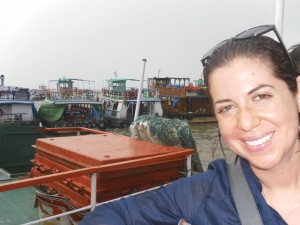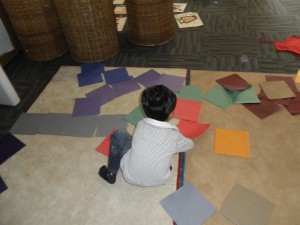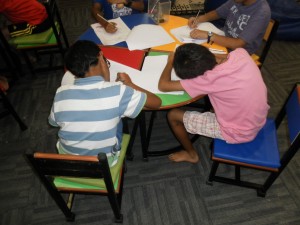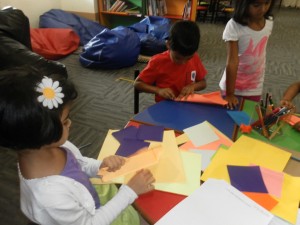 Our experience had begun with trumpeted fanfare, a cacophony of greeting and questioning and learning and exploring. The unknown — three weeks’ worth -– stood before us, whoever we were – the kids, my recently met colleagues, myself in this role, all of us together. The roar was deafening.
Our experience had begun with trumpeted fanfare, a cacophony of greeting and questioning and learning and exploring. The unknown — three weeks’ worth -– stood before us, whoever we were – the kids, my recently met colleagues, myself in this role, all of us together. The roar was deafening.
Our last day slipped away quietly, quiet and quieter still. Fewer children than usual attended the morning session due to one family’s vacation; the independent, engrossing activities were familiar to our group of young friends; exhaustion subtly subdued the volume of my speech. I supervised one aspect of the post-test, an assessment whose validity we doubted as paper airplane-folding was neither taught explicitly nor affected necessarily by enriched aerodynamic understandings. A different indicator should be used to demonstrate programmatic impact – but which? The children filled out pre- and post-intervention forms in which they were asked “how do things fly?” While this question is more apt, the data are murky. The younger children’s drawings require (subjective) coding and accounting for the difficulty with which children comprehended this query; the older children’s words were liberally shared amongst themselves – a tactful way to say plagiarized. What do we really want to know, anyway? Was the point of this program to deeply teach science, or to introduce the scientific process, or to stimulate curiosity, or to build community, or to entertain? What are we practicing, what are we preaching, and what are we measuring and passing off as proof?
As Emily and Malika prepared our room for this session’s final Open House, setting up stations where parents could examine the past week’s science experiments, I channeled the children’s energy through mellow imagination and music. We began with “Down by the Bay,” a song-game that requires volunteers to supply a silly rhyme. This led into a round of “Miss Laurel Says,” from which we transitioned into a guided imagery experience in which all of the children were instructed to array their bodies as though they were sleeping on the floor of the ocean. One-by-one, they were invited to recount their dreams. Then we sang “Little Cabin in the Wood,” a song-game that has children use their hands, hum verses progressively and, crucially, focus for at least five solid minutes. From there, we revisited “Aiken Drum,” a song-game in which volunteers suggest the composition of this man (e.g., his teeth were made of corn).
When the parents finally arrived, I spoke about our philosophy of learning through play and narrated the slideshow of classroom snapshots. Then their children shepherded them through our classroom, demonstrating experiments and explaining, to the extent that their comprehension allowed, why larger parachutes stayed aloft longer/bigger balloons shot forward faster and further/etc. I tried to speak to every parent in attendance, praising and sharing anecdotes about their children. They slipped away unobtrusively, as I struggled to rethread the balloon rocket or detach the balloon helicopter. And then they were gone. It was over.
Our lunchtime lull was placid – easy conversation over homemade favorites from Vasundhara’s mother, a trip to the nearby strip mall and return to our apartment to deposit Emily’s newly acquired purchase. I brushed my teeth. We walked back to the World Trade Center, no frantic setup required, no cramming of science lore, no drafting of a daily newsletter.
The afternoon was similar to the morning – more futile airplane folding, more focused concentration among the kids. I traded my soothing tones for slaphappy giggles and led the group in theater games – “What Are You Doing?” and “Dr. Know-It-All.” To my delight, the children let go of hesitation/overcogitation and let their words spontaneously flow. Trust.
With the parents’ arrival, I again rattled off my spiel about the value of learning through play, then facilitated the children’s narration of our slides. They raised their hands to answer my questions, fill in missing words, demystify photographs. I tried to call on them equally, all of us showing off in front of the parents. Masterful – that was the students’ command of scientific principles and vocabulary. How ’bout that?
Afterward, parents related their children’s enjoyment of the program, the extent to which they had brought their learning home for discussion and recreation. One child, a mother confided, had sent the maid out for plastic bags and strings so that he could build and drop parachutes off his upper bunkbed.
“Goodnight and thank you, miss,” one of our favorite students said for the last time. “Goodnight and thank you, sir,” I replied.
Shoeless, a team of laborers deconstructed our classroom and carted it all away. We teachers lamely offered to help, knowing that heavy lifting was forbidden and sophisticated organizing was illogical, for soon we would be carted away too, and then who would know where to find the pingpong balls? I’d documented our classroom’s emergence but let it dissolve anonymously. The room’s dividers were pushed back and the space that had defined 10 hours of my day, for 3 weeks of my life, was swallowed up by the expanse from which it had emerged.
Wearily, unceremoniously, we walked out, neither sentimental nor celebratory. But Emily observed, “It will take them years to get out the glitter.”
I hope so.



